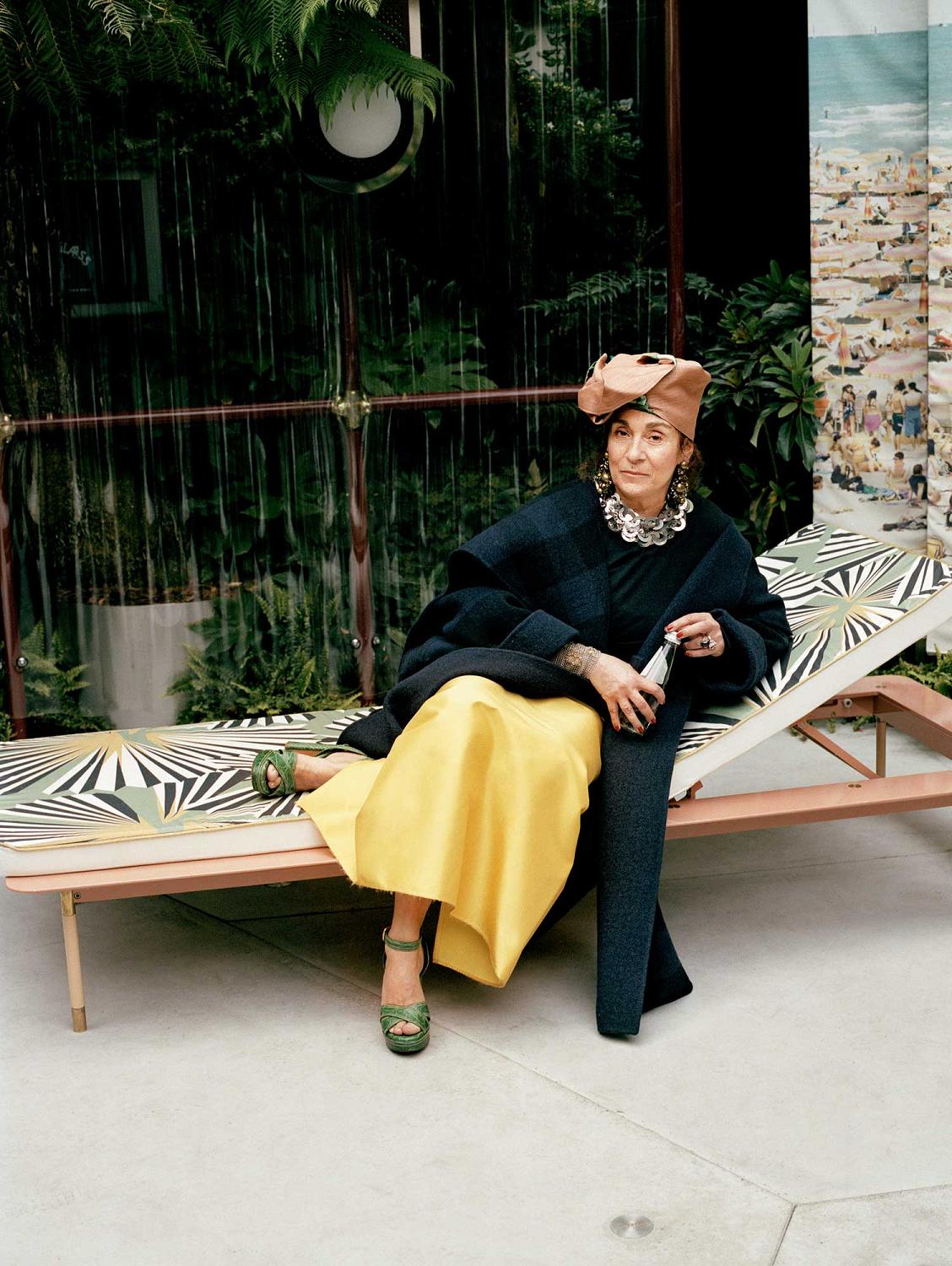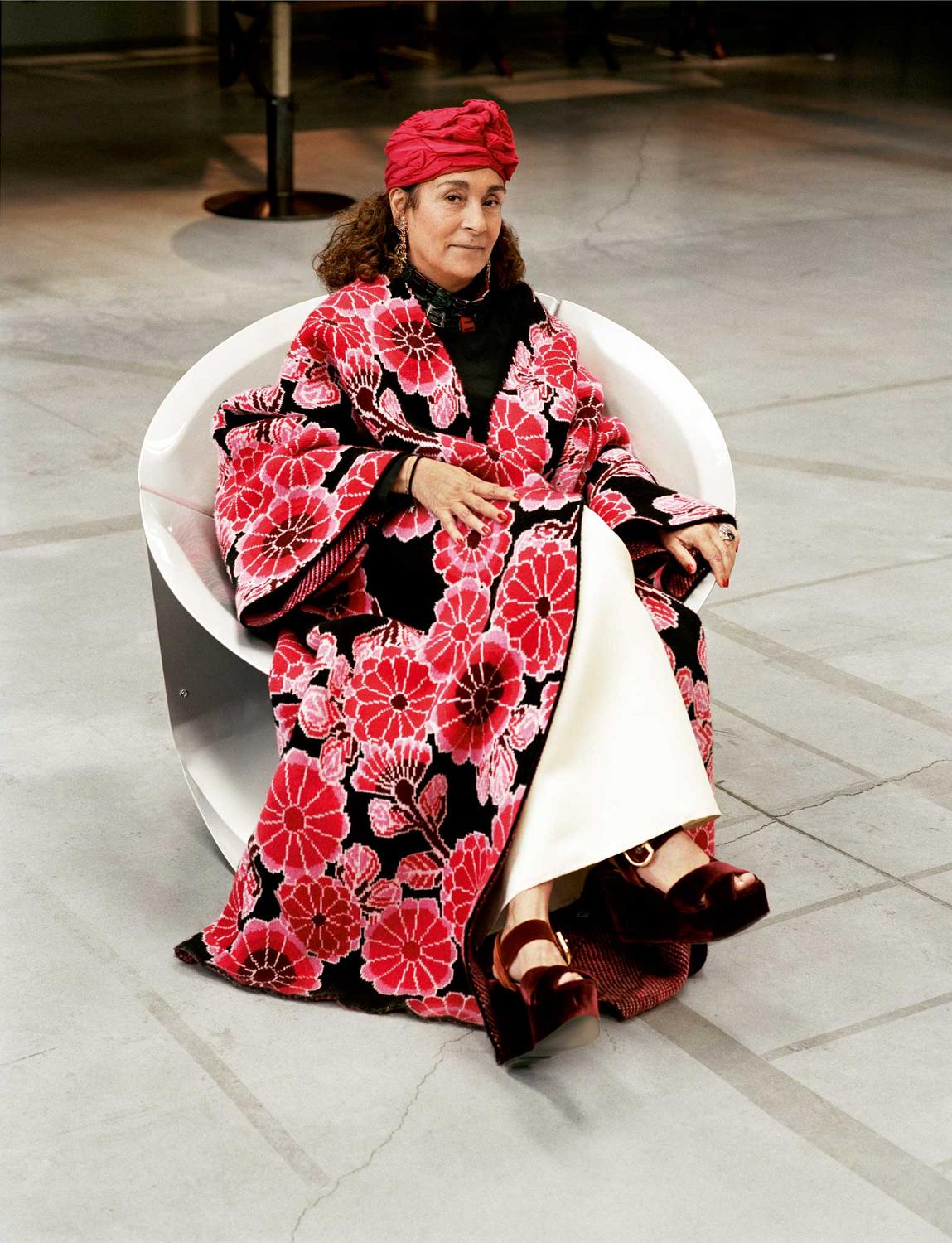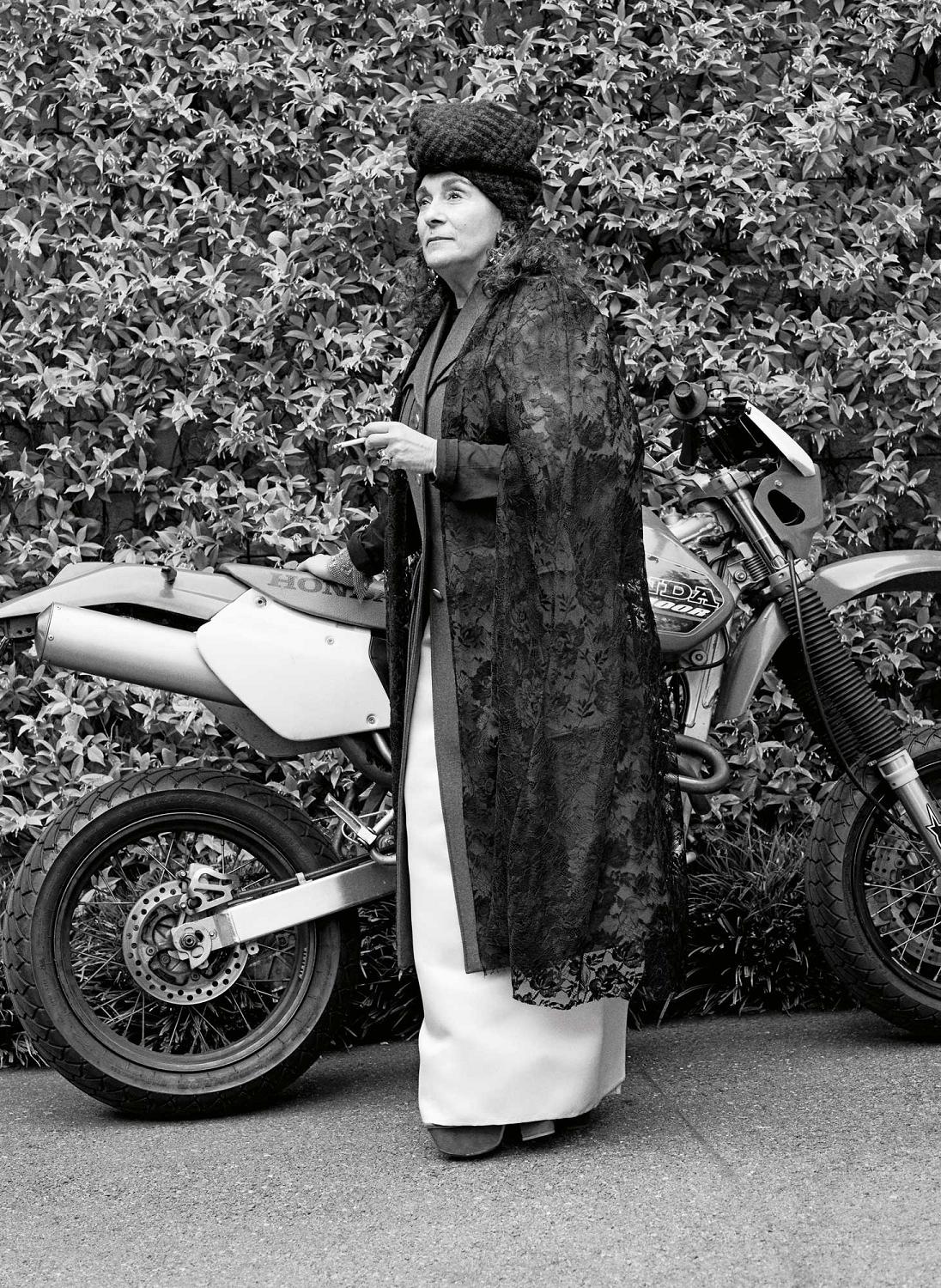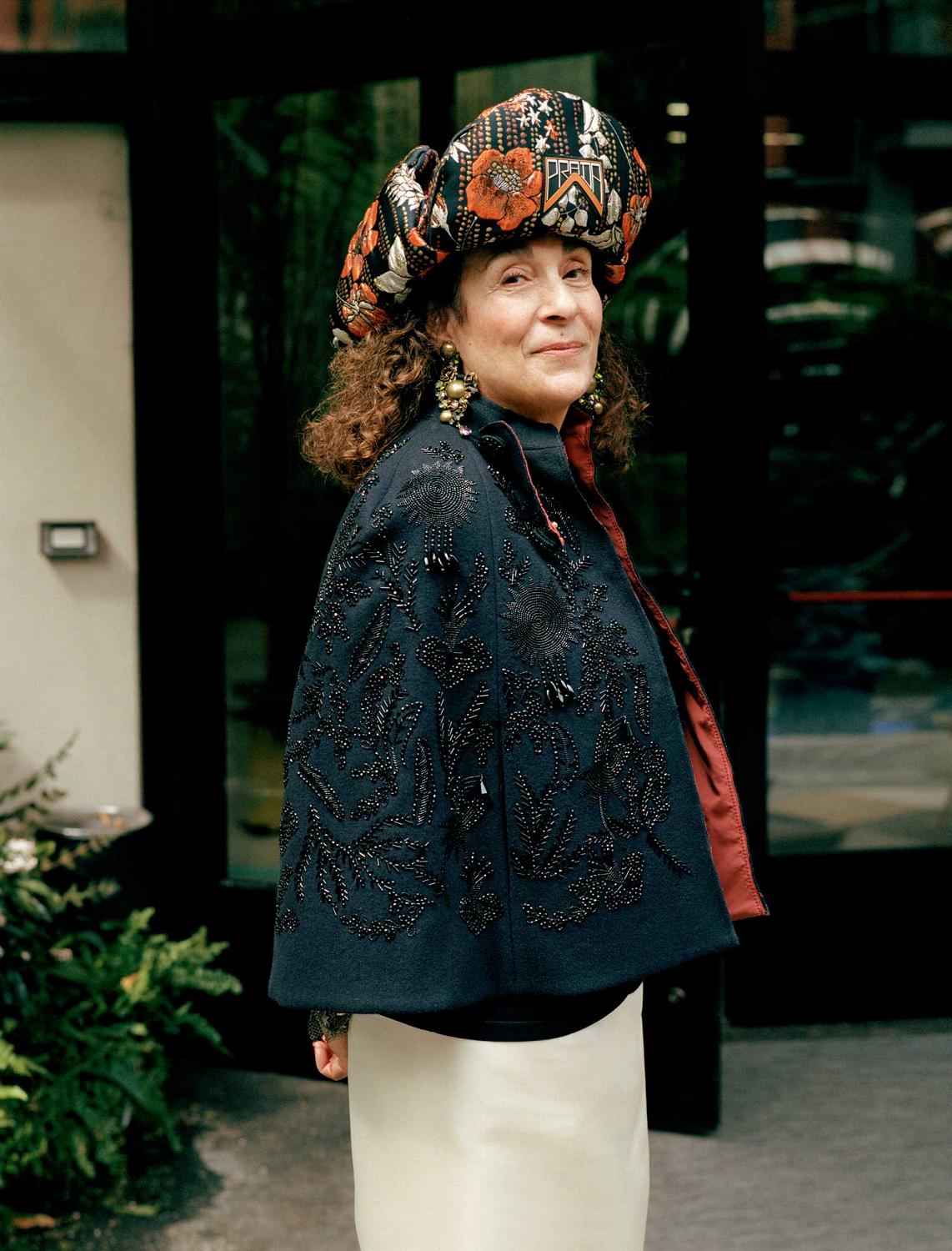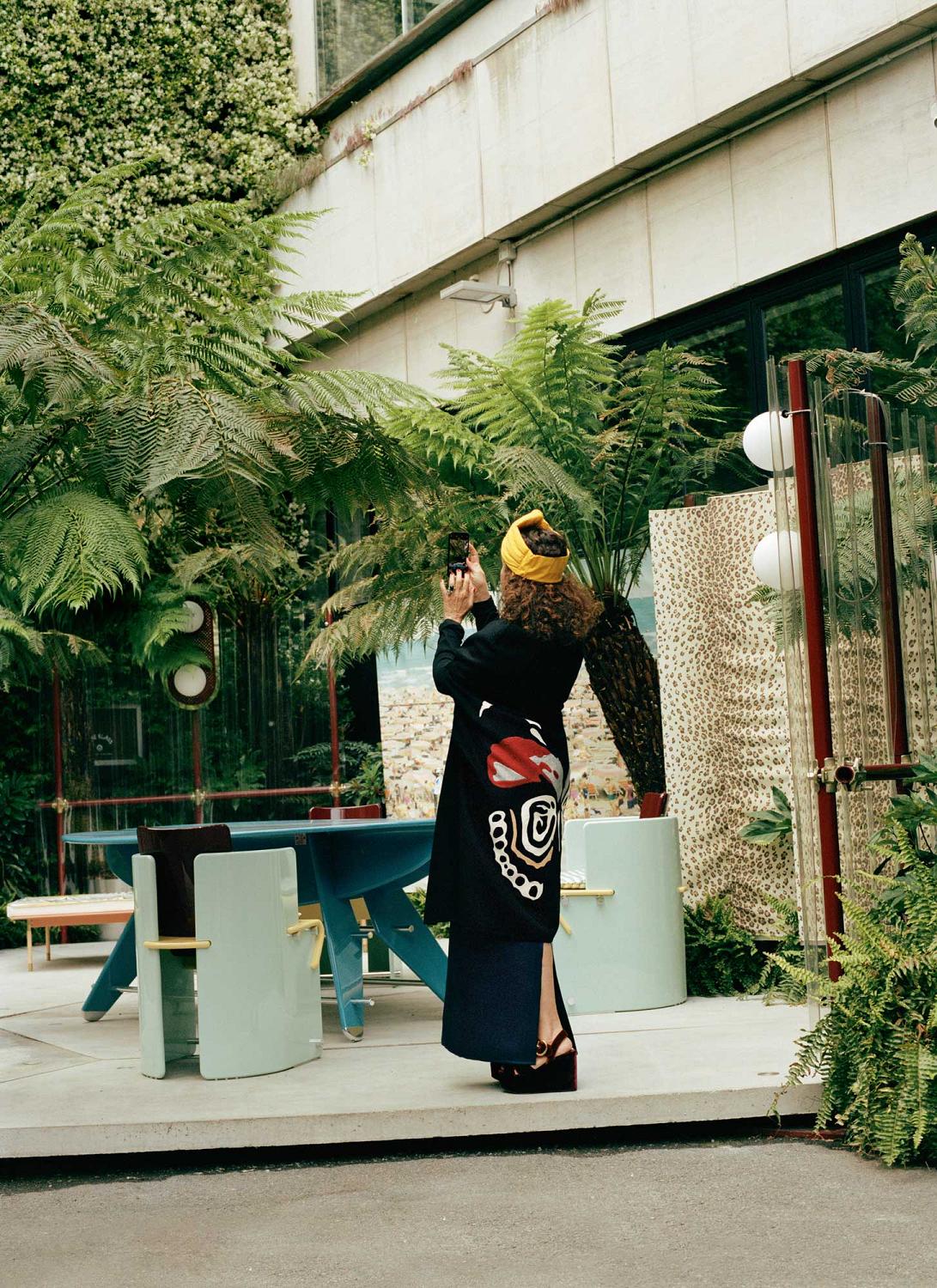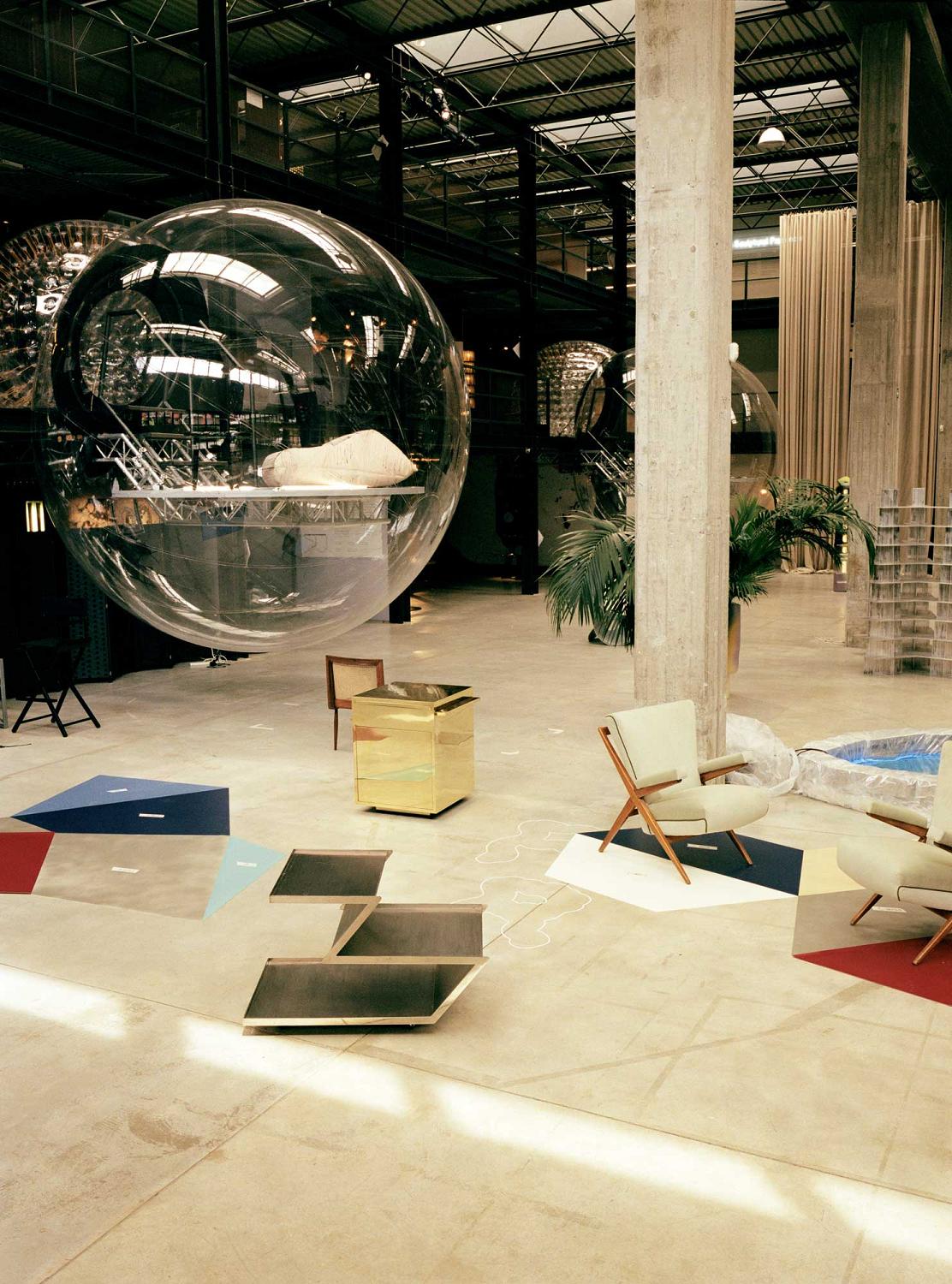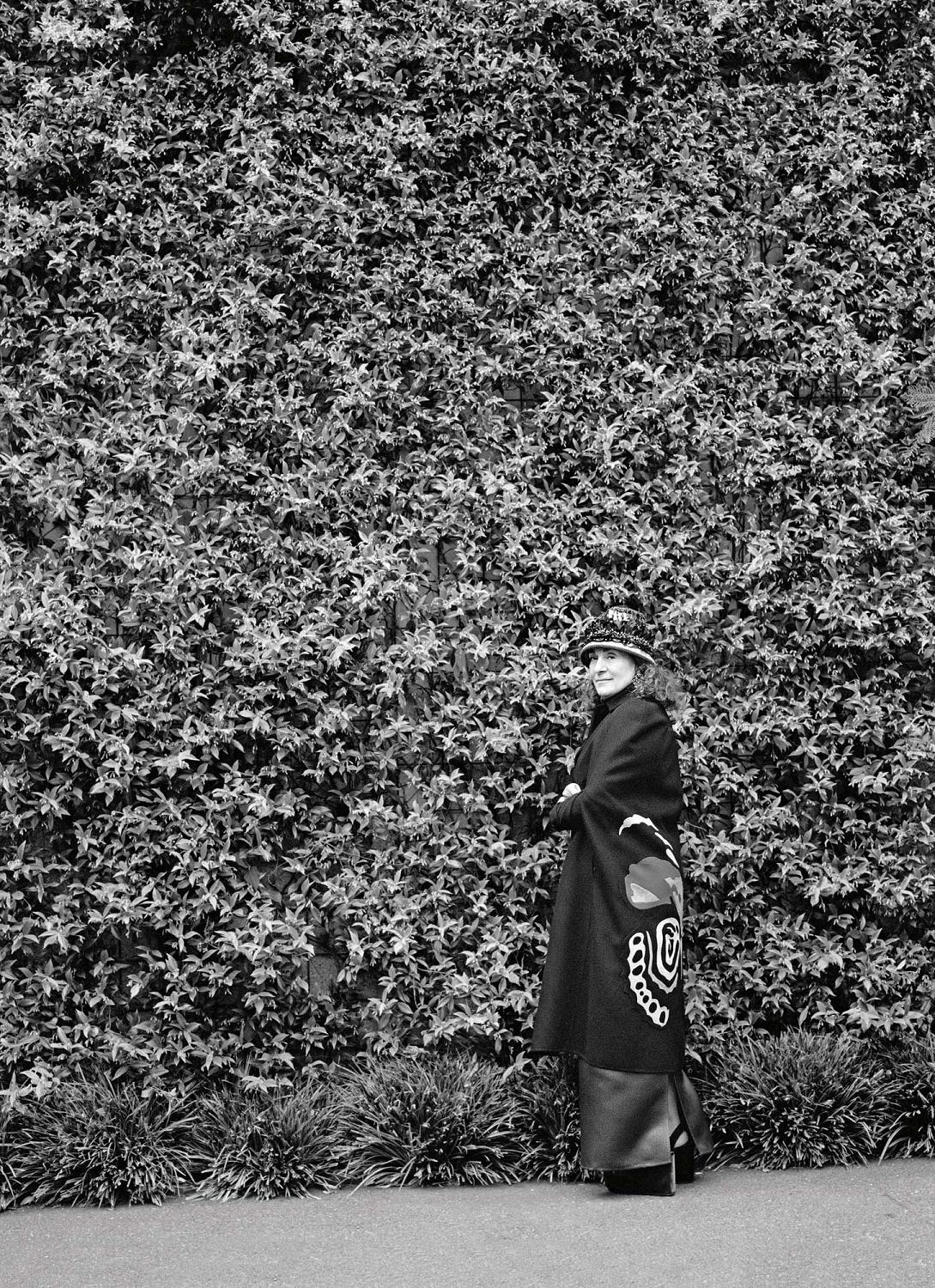The Wardrobe with Nina Yashar
Nina started completing her outfits with turbans more than 20 years ago. Back then, she says, “nobody wore them. But I have always loved eccentric and strange things, and they reminded me of my ancestral heritage. After all, I was born in Iran; they must be in my DNA.” She owns “about 50”, most of which are from ALTALEN, including the tan linen folded one she wears here. “The shop, which is near my apartment, is run by women who sew everything by hand; their workmanship is incredible.” Nina’s necklace of interlocking steel rings is by the Italian jewellery designer GianCarlo Montebello. “It immediately elevates any outfit I am wearing,” she says. Here, that’s a black cotton T-shirt and primrose satin column skirt, both by PRADA, underneath a navy checked wool coat by PRINGLE OF SCOTLAND, with emerald leather platform shoes by PRADA. Nina wears her own jewellery throughout.
The fuchsia silk organza turban that Nina wears here was made for her by ALTALEN. Nina’s milliners of choice provide another valuable service, too. Once a year, she takes the headpieces she wears most often for what she calls “maintenance and refreshing”. The turbans are steam-cleaned to restore them to their original form, Nina explains. “Sometimes they get a bit squashed in certain places, but after servicing, they’re as good as new.” Knitted flower-pattern Kimono coat by BALENCIAGA. Ivory satin column skirt, Nina’s own. Black T-shirt and claret velvet platforms both by PRADA.
Nina has been visiting her trusted Milanese tailor for years. “Everyone should have one,” she says. “If I buy a garment I like, I love having it in different colours and different textures, so I take a selection of fabrics to my dressmaker and we find a similar pattern to make.” One such staple is a column skirt in duchesse satin, such as the ivory one she wears here and on the opposite page. She also has versions in red, pink, green, teal, navy and brown. “If you wear a very striking statement piece on top, then you need to balance it with something very simple underneath,” Nina says. She wears the skirt with a black lace cape over a sleeveless khaki coat, both by PRADA. Folded wool hat by ALTALEN; black cotton T-shirt and claret platforms as before.
Choosing clothes and combining them in eclectic outfits is something that Nina does “very easily, very intuitively and very fast”. She thinks it’s because “it’s what I do every day in the gallery.” Here, she wears a floral brocade trapper hat by PRADA that she fell in love with “the second I saw it, because it’s such a clever reworking of those hats with flaps typically worn by mountaineers.” She combines it with an embroidered navy wool cape and black T-shirt, also by PRADA, and her own ivory skirt.
“I pass Valentino twice a week when I walk to my gallery on Via della Spiga,” Nina says, “and I admired this cape in the window for the longest time. In the end I bought it. I’ll still be able to wear it in 10 years because it is ageless — and this is one of the guiding principles of how I choose clothes.” Nina wears the black cape with giant butterfly by VALENTINO with her own teal satin column skirt and the velvet platforms by PRADA. The yellow silk organza turban by ALTALEN is one of Nina’s favourites.
Nina opened Nilufar Depot in 2015 — 1,500 square metres over three floors to display items she has spent 30 years amassing. Just north of Milan’s Porta Garibaldi station, the Depot is a world away from her gallery on Via della Spiga. Its vast interior was designed by the Italian architect Massimiliano Locatelli, whose chairs and sofas Nina sells. The Depot houses some 450 pieces, ancient and modern.
The jewelled bucket hat is by PRADA and, Nina says, “encapsulates the genius of the woman. Who else would combine a wool rim at the bottom with sequins and beads and netting which recall Middle Eastern head coverings at the top?” Nina wears it with the embroidered butterfly cape by VALENTINO, her own teal skirt, and the velvet PRADA platform sandals.
Nina Yashar spent four decades building a reputation as a design-world paragon of taste — her eye for Persian rugs plus midcentury masterpieces is unsurpassed. But 14 years ago the Milan dealer did the unthinkable and threw in her lot with living designers. Certainly a risk, Nina, 60, admits, but commissioning work from one’s contemporaries is the greatest gift, as her extraordinary wardrobe attests.
“You cannot teach good taste. There’s no script for it. It’s not possible to elaborate a theory for it. Yet it exists,” Nina Yashar tells me. She knows of what she speaks. She has built her reputation as one of Italy’s top design dealers on her ability to display together objects, carpets and furniture from every time and place in harmonious ensembles.
Nina’s multicultural, cross-temporal approach to design now features prominently in galleries and collectors’ homes. But when she started she was a pioneer. She was one of the first to display, say, the work of the midcentury Finnish designer Alvar Aalto with Middle Eastern carpets, setting a new benchmark. “I don’t know how she does it so much better than most, but she does,” says Libby Sellers, the curator and design historian, who has collaborated with Nina on several projects.
So it seems entirely appropriate that I should find myself sitting at Nina’s feet in her elegant fifth-floor two-storey apartment in Milan, gazing up at her in her yellow bird-of-paradise-print dress by Fendi. Nina has not asked me to adopt this reverential pose, obviously. My back is sore from a sleepless night and her unyielding sofa was making it worse. “My daughter finds this sofa uncomfortable, too,” she says, peering down at me. “It’s true that it’s not the kind of sofa you can sink into to watch television.” Nina bought it from a Berlin gallery 20 years ago — it was made in the 1950s and once graced a German government office — and reupholstered it in sumptuous grey velvet. “I don’t deny that I sometimes privilege aesthetics over comfort,” she adds.
In her clothing, too, Nina admits that “there are some garments which I find so striking, that give me such joy, that I wear them even though they are not necessarily comfortable.” She chooses clothes the way she arranges objects in her gallery, mixing disparate items into eclectic, elegant outfits. She combines high fashion — a bold, theatrical cape by Prada or Valentino, perhaps — with the signature silk turbans she owns in every colour, and textiles she discovers while searching in far-flung places for objects for her galleries — some Vietnamese cloth that she wraps around her waist; a dress bought on Patmos, her favourite Greek island. “You can find good design anywhere,” she says, “if you have the eyes to see it.” And Nina does.
Earlier in the day, I had visited Nilufar Depot, the spectacular showroom in Viale Vincenzo Lancetti that she opened in 2015. Her galleries are named after her sister, whose name, Nilufar, is the Farsi word for lotus flower, in a nod to the family’s Iranian ancestry. The vast space, designed by the Milan-based architect Massimiliano Locatelli, consists of a soaring central atrium flanked by three floors of black metal balconies behind which are alcoves where furniture and objects are displayed in seductive mises en scène.
One of these in particular strikes me. A low octagonal table in jacaranda, made in Brazil in 1960 by the Polish designer Jorge Zalszupin, is positioned near a 2018 green velvet sofa and chair by the Lebanese designer Khaled El Mays — part of a collection Nina commissioned for her gallery — and two rattan armchairs from the 1950s by the Italian Franco Albini. Underneath them all, uniting the space, is a French carpet with a check pattern in alternating tan and beige squares topped by five large pink stars. The rug looks contemporary but, astonishingly, dates from the mid-19th century. The effect is seamless: these forms, materials and colours were meant to be shown together.
When later I tell Nina how much I love this group of objects, she smiles. “It’s not enough to combine beautiful things,” she says. “The items you choose need to be in conversation with one another; get just one thing wrong and you will fail.”
Nina started her business nearly 40 years ago, when she was 22, opening her first shop in Via Bigli in Milan’s elegant historic centre to sell luxury carpets. She had learned her trade from her father, Houchang Yashar, who set up a Persian rug dealership in the city when he moved the family there from Tehran when Nina was six. But Nina took a very different approach to him. Her father searched for rugs that would appeal to a broad public, whereas for Nina all that matters is that “the works I sell please me. And in any case, I have always believed that it’s easier to sell difficult, unusual pieces; the strangest pieces are the first to go.” Her clients include many “highly creative people who appreciate new things and ideas,” she says, including her lifelong friend Miuccia Prada. The pair met when Nina was 18, when they both joined feminist protests on the streets of Milan during the movement of 1977, marching side by side. “We were both very political back then,” Nina says. Four decades on, they are still “very close,” she adds; while we speak she is briefly distracted by an exchange of text messages with the designer that makes her giggle.
The duo’s ties, both personal and professional, run deep. Nina’s husband, Angelo Coletto, worked for Prada for 21 years, as a sales manager for Prada Linea Rossa and Church’s, before retiring last December. The couple have one daughter, Lavinia, 27, a doctor specialising in autoimmune diseases and rheumatology.
In 1989, Nina moved into her current gallery, Nilufar, in Via della Spiga, home of Italian luxury fashion. Over the years, she began to add furniture to her rug displays, starting with Scandinavian and Italian midcentury designers before widening her reach to incorporate exceptional objects from around the world — from Nepal to Japan to Brazil. But the turning point came 16 years later. It was 2005, and a new contemporary design fair was launching in Miami as a sister event to Art Basel Miami Beach, the North American edition of the historic Swiss art fair. At the time, contemporary art was attracting a new generation of buyers, from Wall Street investors wanting to diversify their portfolios to property developers and music industry professionals. But “many of these people were displaying their newly acquired paintings in poorly decorated homes,” Nina recalls, with a disapproving frown. “Their furniture was absolutely not of the same quality as their art. The Miami design fair was an attempt to educate art collectors about the value of design.” Nina was, she says, faced with a choice. “Do I stick with historic design, or do I jump into this new un-familiar world? I have always loved risk, so I jumped.”
Since then, Nina has worked with young, sometimes volatile designers. “It takes an immense effort,” she says. “It’s so much easier to deal with dead designers than with living ones. The experience has taught me compassion and patience — so much patience. Young designers can be so insecure. I speak to them more often than I speak to my own family!”
The collaborations provide a lifeline for new makers. “The design market is still focused on historical pieces,” Libby Sellers says, and even designers lucky enough to create products for major retailers don’t make much money, because “royalties on mass-manufactured pieces are really tiny. So gallerists like Nina who sell contemporary design are critical for them.”
One of Nina’s protégés is the London-based Martino Gamper, to whom she was introduced by Ron Arad, then his teacher at the Royal College of Art. At the time, Gamper was refashioning chairs he found on the street, one per day. The resulting 100 Chairs in 100 Days project so impressed Nina that she bought the massive installation. “That is not design, that is art,” she says. Nina has loaned the work to museums around the world, including the Benaki Museum in Athens, the MIMOCA museum in Marugame, Japan, and the City Gallery Wellington in New Zealand. Now, it is in her vast storage space outside Milan. “It’s such a pity that it’s boxed up where nobody can see it,” she says.
What other treasures does she have in storage, I wonder? Nina smiles. “I am a serial hoarder. I could stop buying and have enough stock to last me for the next 10 years.” But she won’t. She is restless, always searching for new challenges. A dream is to design the sets for an opera or theatre production. “That would be the most fun,” she says. “I wake up in the middle of the night and think about my window displays or about the shows I’d like to organise or new projects I’d like to embark on. I do live somewhat in my own head. Everything I do begins with my imagination.”
As we share a cigarette on her long balcony overlooking the handsome residential streets far below, the conversation turns somehow to the recently screened finale of Game of Thrones. “I cried during the final episode,” Nina tells me. “My husband and I are both obsessed with the show.” She loved the series’ “exceptional” costume and set design, with its “extraordinary” attention to detail, and of course the gripping storylines. “I was hoping for a spin-off series with the same characters,” she says. When I tell her that a prequel set thousands of years before the action of the main series has already started filming, she dismisses it with an impatient wave of her hand. “Why would we want a prequel when we already know how the story ends?” Then she pauses, before leaning towards me conspiratorially. “Imagine if I staged an exhibition of Game of Thrones set designs and costumes in my showroom… Just imagine.”
Cristina RuizA distinct and intelligent voice in arts writing who has interviewed Barbara Kruger, Rachel Whiteread, Catherine Opie and Shirin Neshat for The Gentlewoman, Cristina is the former editor of The Art Newspaper who has also contributed to Vanity Fair, the Financial Times, UK Vogue and The Sunday Times Magazine.…read more Portraits by
Paul WetherellPaul Wetherell is a photographer from London who is renowned for his sensitive portraiture and elegant fashion stills. His photography has appeared in many publications such as Another, Fantastic Man, i-D, UK Vogue, WSJ and 10. He is represented by the quite fabulous Julie Brown at M.A.P., who can be…read more
Styling: Samantha Logan. Hair: Matt Mulhall at Streeters. Make- up: Helena Komarova at Close Up Milano. Photographic assistance: Chris Miller, Bruno Conrad. Styling assistance: Caio Deazevedoreis. Production: M.A.P. Post-production: Rabbit Retouch.
This profile was originally published in The Gentlewoman nº 20, Autumn & Winter 2019.